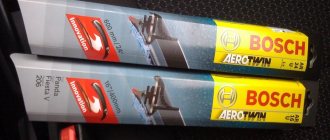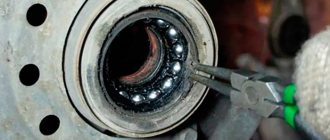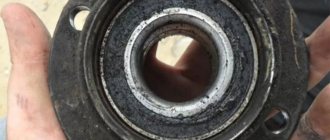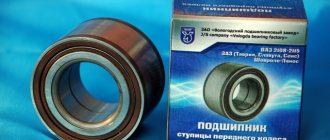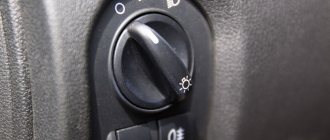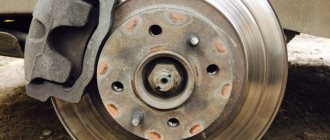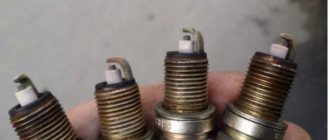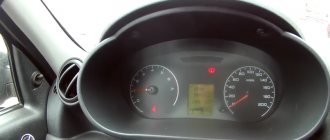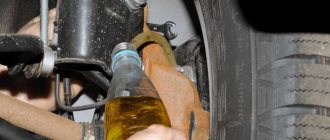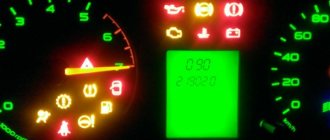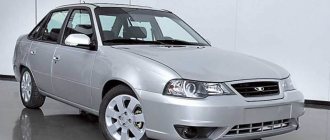A wheel bearing malfunction is a common failure during the operation of a technical device. The reason for premature wear is poor-quality road surface and aggressive driving style.
Front wheel bearing
Replacing a wheel bearing is done independently, without special equipment, experience, or skills. Subject to the availability of spare parts, the replacement process will take no more than an hour, without the cost of car service.
Where are the front and rear hubs on the Lada Grant? Description, purpose
The front hub joint is located on the front left (right) side of the axle shaft. The rear hinge is located in the rear left (right) suspension block.
The main purpose of the bearing is to firmly hold the hub and ensure wheel rotation. Structurally, the front (rear) hub consists of:
- outer and inner metal frame;
- a separator in which metal balls and rollers are located;
- insulating rings;
- special filler - graphite-based lubricant.
Diagnosis of wheel bearing failure Grants
The front wheel bearing on the Grant is not the most vulnerable part in the suspension, but its failure is possible after a mileage of 80,000 km or due to external and internal factors. A malfunction of the front hub is determined by the following signs: - Noise from the wheel while driving (damaged ball bearing parts: rolling elements, raceways or cage); — Vibration, wheel beating, grinding (typical of a broken ball bearing); — Front wheel play (the ball bearing has failed or the wheel nut is not tightened with sufficient torque). — Watch the video with the characteristic noise when a hub unit breaks:
Diagnostics of the front hub bearings proceeds as follows:
- The front of the car is raised with a jack;
- Spin the wheel by hand and check for noise;
- Check the axial play (clearance) according to the instructions. #
- If you hear a noise or notice other signs, then replacing the front wheel bearing on Granta is inevitable.
- Be sure to watch the diagnostic video.
The device of the hub on the Lada Grant
Front
- rounded fist;
- external and internal dirt-reflective metal rings;
- front roller bearings;
- hub;
- washer;
- hub nut;
- retaining ring, plug.
Rear hub device
- hub mechanism axis;
- metal ball bearing;
- mud ring;
- retaining ring;
- washer;
- screw;
- sealing ring;
- rubber boot;
- hub cover.
Resource for replacing hub mechanism elements
The average service life of wheel joints is 80 – 85 thousand km. The indicator is average, as it depends on the following factors:
- quality of workmanship of the part;
- frequency of operation of the technical device;
- driving style;
- quality of road surface;
- aggressive environment;
- high operating temperatures;
- compliance with technical inspection intervals.
Signs that a hub needs to be replaced
- the appearance of uncharacteristic noise during wheel rotation;
- wheel runout in the steering column;
- vibrations at different speeds. Sometimes there is vibration at a certain speed;
- metallic grinding noise as the wheel rotates;
- front wheel hub play.
Diagnostics of the hub mechanism
- We place the car on a level platform, squeeze the parking brake if we are checking the front row. For the rear, we install wheel chocks.
- Let's jack up the front (rear) part.
- We turn the car wheel and carry out troubleshooting.
- We shake the wheel up and down with our hands. In good condition there should be no play. Otherwise, we dismantle and replace worn elements.
How to change rear pads on a Lada Granta
An anti-lock braking system can be installed on the Lada Granta. Replacing Grant rear pads with and without ABS is practically no different. The only difference is the presence of a sensor, which must be disconnected when changing the ABS pads.
Attention: rear pads should only be replaced as a set. It is unacceptable to change the pads on only one side;
Before replacing the rear pads of the Lada Granta, you should check the brake fluid level
If it is close to the maximum, you need to use a rubber bulb to remove some liquid into the prepared container.
Before replacing the rear pads of the Lada Granta, you should check the brake fluid level. If it is close to the maximum, you need to use a rubber bulb to take some liquid into the prepared container.
The pads are changed in stages: first on one side, then on the other.
Replacing the Grant rear pads is done as follows:
- fully lower the handbrake lever;
- loosen the tension on the handbrake adjusting bolt;
- unscrew the guide pins holding the brake drum;
- clean the brake drum seat located on the wheel hub from dirt;
- treat the seat with WD-40;
- tap the drum with a rubber-faced hammer to facilitate subsequent dismantling;
- screw the bolts into the threaded holes on the drum and compress the drum, tightening the bolts evenly;
Attention: if you press the brake pedal with the brake drum removed, the pistons may fall out of the brake wheel cylinder, so this is not permitted!
- carry out a visual inspection of the brake drum (there should be no cracks, chips, deep marks);
- using a pair of mounting blades, bring together the rear pads of the Grant;
- Using pliers or a slotted screwdriver, remove the end of the upper spring that tightens the pads;
- disconnect the upper spring;
- lower the front pad and remove it together with the lower spring that tightens the pads;
- remove the upper tension spring;
- remove the spacer bar;
- remove the hook of the brake spacer lever from engagement with the parking brake cable;
- remove the second (rear) block;
- Unscrew the axial pin of the spacer lever using pliers;
- remove the washer from the block;
- disconnect the spacer lever and axial pin;
- clean the mechanism parts from corrosion and dirt;
- make sure there is no leakage of brake fluid from the working cylinder (if the cylinder is leaking, it must be replaced);
- attach the axial pin, spacer lever and spring to the new block;
- install the block;
- Use pliers to install the cotter pin on the axial pin;
- hook the end of the handbrake cable to the spacer lever;
- install a spacer bar;
- put the second block in place, having first put the lower spring on the blocks;
- Use pliers or a slotted screwdriver to tighten and install the upper tension spring;
- install the brake drum;
- tighten the two guide pins;
- press the brake pedal several times until the pads are in the working position;
- install the wheels, tighten the fastening bolts;
- remove the car from the jack;
- replace the pads on the second wheel.
Now you know how to replace the rear pads of the Lada Granta and you can do it yourself.
Preparatory stage before replacing the hub mechanism
Required materials and tools:
- hydraulic (mechanical) jack;
- wooden stand;
- wheel wrench;
- screwdriver with a flat, cross-shaped bit;
- hammer;
- knob, nozzles;
- spanners;
- stationary vice;
- chisel;
- two-jaw and cup pullers. The exact dimensions of the pullers are indicated in the operating instructions;
- forceps;
- metal brush;
- lubricant type “CV joint - 4”;
- rags;
- caliper for measuring diameter;
- new wheel bearings;
- additional lighting provided that the work is carried out in the dark.
Replacing the rear wheel hub of a Lada Granta
- We place the car within the perimeter of the repair area and secure the front row of wheels with wheel chocks.
- Using a wheel wrench, we tear off the mounting nuts, jack up the car, and remove the wheel.
- We unscrew the screws securing the brake drum to the structure.
- Remove the hub cap and remove the axle shaft from the splines.
- We fix the structure in a stationary vice. Gently tap the outer edge with a chisel.
- If necessary, use WD-40 liquid to remove deposits and rust.
- We dismantle the hinge and use a vice, although some craftsmen use special pullers. In general, whatever is more convenient for you.
- Using a metal mandrel, we knock out the inner ring.
- To finally press out the hinge, use a hammer and chisel and gently tap along the outer perimeter of the frame.
Replacing the front hub of Lada Granta
- We place the car within the perimeter of the repair area and provide priority safety measures.
- Let's jack up the right (left) side.
- Unscrew the bolts and remove the wheel.
- Let's unlock the hub.
- On the back side, unscrew the two bolts that guide the brake caliper.
Location of two bolts
- We remove the caliper, hang it on a wire (we fix it on the steering tip).
- Unscrew the hub nut and remove the brake disc.
Removing the hub nut
- We unscrew the two bolts - the rack clamps. If necessary, we use a liquid to remove deposits like WD-40.
- Disconnect the strut with the steering knuckle and unscrew the ball joint fasteners.
- We remove the CV joint.
Next, install the new hub assembly and assemble the structure in the reverse order.
Replacing the front wheel bearing of Lada Granta
- The front hub joint is located in the steering knuckle housing, remove it. Pre-clamp the structure in a stationary vice.
- We install the metal spacer - the head at “22” on the surface of the hub. We apply targeted blows with a hammer to press it out.
- We disconnect the inner race of the hinge and remove the separator with metal balls.
- To remove the outer part of the hinge, use pliers and remove the retaining rings.
- To dismantle the inner part of the cage we use a chisel. Gently tap with a hammer. Press-out puller
- Use a puller to press out the axle shafts.
Pressing in a new wheel bearing and assembling the unit
- We clean the surface from dirt, deposits, and rust. We remove the old grease from the hub and wipe it with a rag. We measure the diameter of the hub, it should be 35 mm.
- Apply a thin layer of graphite grease to the surface. Press in the new bearing.
- We press the hinge until the retaining ring comes into contact with the edge of the part.
- We insert the hub into the hole using a vice.
Replacing the rear wheel bearing of a Lada Granta with your own hands
Note to the driver!!! Before starting installation work, clean the surface from debris and dirt. Apply a thin layer of oil and be sure to lubricate the outer race of the hinge.
- We install the new hinge and lightly press it into the cavity.
- Evenly tighten the hinge until it touches the outer edge.
- We fix the retaining ring and install the hub in its original place.
Installation in a regular place. Assembly of the structure
- Apply a thin layer of graphite grease, put the assembly on the shaft, and secure it with a nut.
- We complete the tightening with a torque wrench (tightening torque 30 Nm).
- Use a chisel to counter the nut and put on the cap.
This completes the disassembly, assembly, and replacement of the rear wheel bearing.
Note to the driver!!! The Lada Granta Sport modification has a rear hub with a pre-installed ABS sensor.
It often happens that during the process of dismantling the hub mechanism, a bolt or pin breaks. The reasons for this are different, ranging from the old age of the metal to manufacturing defects.
So, how to remove a broken bolt. We carry out the work in several stages:
- mark the center of the stud;
- drill with a drill to 2.5, after 5.5, 9.5 mm;
- scroll with a bolt with a diameter of 9.5 - 10.0 mm;
- remove remaining metal and shavings.
Lada Granta, replacing the rear wheel bearing with your own hands. Photo and video instructions
We have a Lada Granta car under repair, on which the rear wheel bearing needs to be replaced. We will show you detailed photos and video instructions on how to do it yourself.
In addition to the usual tool, we will use a puller, which consists of a power screw, a glass and a set of washers.
We carry out the work on the rear left wheel. Use a 7 key to unscrew the guide pins:
To remove the drum, we screw M8 threaded bolts into adjacent holes.
If the drum has not been removed for a long time, a so-called “shoulder” of oxides forms between the hub and the drum; before you begin removing the drum, you must remove all of this. This is done using a chisel and a hammer.
Next, we remove the ABS disc by hand. We remove the protective plastic cap; it has a small groove into which we insert a slotted screwdriver and move it to the side. Use a 30mm socket to unscrew the hub mounting nut:
After removing the nut, we are left with a washer; the most convenient way to get it out is with a magnet. We press the hub assembly, but be careful, there is an ABS sensor in the front part, which can easily be damaged. For work we use a three-legged puller, but you can get by with a two-legged one:
Turn the screw and compress the hub. Usually this procedure goes without any difficulties, the only unpleasant moment that can arise is when one of the rings remains on the shaft. In our case, this is what happened.
In order to remove the half ring that we have left when pressing out the bearing, we use a more compact two-legged puller.
We secure the hub in a vice, we first need to remove the retaining ring, but before we compress it with pliers, we move it a little, since over time it gets stuck and is difficult to compress. To move it, use a strong screwdriver and a hammer, delivering several sharp blows:
After that, take tongs or pliers, squeeze the locking ring and lift it up. Now we need a special tool - a power screw, which we wrote about earlier.
Turn the screw to press out the old wheel bearing. Then we clean the seat and lubricate the working surface with grease. We clean the surface under the retaining ring using this hook:
After this, press in a new bearing:
Reinstall the retaining ring, making sure it is seated in its groove. Having previously lubricated the seating surface, we install the hub in place. First, we insert it with our hands, then hammer it in with not too strong blows through a suitable mandrel:
Place the washer and nut and tighten. We tighten the hub nut, it is recommended to do this using a torque wrench, the tightening torque is in the range from 180 to 220 Hm. We caulk the nut. We put back the protective cap, ABS disc and drum.
Video of replacing the rear wheel bearing in a Lada Granta:
Backup video on how to replace the rear wheel bearing in Lada Granta:
Source
Review of manufacturer prices for front and rear hinges
How to choose and buy quality parts
Service center specialists strongly recommend purchasing consumables and components exclusively from specialized stores, representative offices, and official dealers.
To a lesser extent, you need to use the services of unverified suppliers who sell spare parts at an unusually low cost.
When purchasing, check the catalog numbers with the actual data specified in the operating instructions for the technical device. If such a brochure is not available, consult a specialist.
Reviews
| № | Positive |
| 1. | Gennady: I’ve been actively using the car for two years, there are no comments on the chassis or suspension. Once I replaced the rubber boot on the left CV joint. |
| 2. | Kirill: I have driven the car over 80,000 km, I can say that the CV joint still has service life, but it is necessary to prepare for repairs. In general, the parts are maintained within the period specified by the manufacturer. |
| 3. | Vyacheslav: the car is a year and a half old, I bought it at a dealership, no complaints. I systematically carry out technical inspections, buy original consumables, and do not skimp on preventative maintenance. |
| 4. | Dmitry: replaced the “grenades” only at 90,000 km. The service station master said that the mileage is good, not every car gets that much mileage. I believe that careful driving contributed to extending the life of the vehicle's chassis. |
| 5. | Leonid: I’m pleased with the build quality of the car, there are no complaints. Breakdowns happen, but they are insignificant, I fix them myself. |
| 6. | Vasily: if you don’t take into account minor flaws, then the car is good, better than previous generations. |
| 7. | Victor: I drove Grant for a year and a half, didn’t do any repairs, visited a service station only for diagnostics. |
| Negative | |
| 1. | Ivan: I replaced the right CV joint for the first time at 45,000 km, after which the left one needed repairs. In general, the workmanship is low, I am dissatisfied with the machine. |
| 2. | Alexander: standard CV joints are weak and poorly made. After purchasing a car, experts recommend installing foreign analogues. True, the cost is 15% more expensive than domestic ones. |
| 3. | Vladlen: after two years of active driving, I can’t say anything bad. Minor defects are present, but they can be easily fixed. |
Conclusion
Provided that the equipment is used moderately on uneven road surfaces, the average service life of CV joints is 85,000 km.
The better the quality of the road surface, the longer the hubs take care of. Original components will only increase the service life of the car. However, not all owners adhere to the recommendations of specialists and systematically save on consumables.
| Video - Changing the wheel bearing on the Lada Grant |
| Video - Replacing the wheel bearing |
